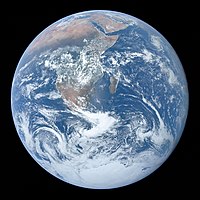
Photo from wikipedia
Metal pollution in white dwarf photospheres originates from the accretion of some combination of planets, moons, asteroids, comets, boulders, pebbles and dust. When large bodies reside in dynamically stagnant locations… Click to show full abstract
Metal pollution in white dwarf photospheres originates from the accretion of some combination of planets, moons, asteroids, comets, boulders, pebbles and dust. When large bodies reside in dynamically stagnant locations – unable themselves to pollute nor even closely approach the white dwarf – then smaller reservoirs of impact debris may become a complementary or the primary source of metal pollutants. Here, we take a first step towards exploring this possibility by computing limits on the recoil mass that escapes the gravitational pull of the target object following a single impact onto an atmosphere-less surface. By considering vertical impacts only with the full-chain analytical prescription from Kurosawa & Takada (2019), we provide lower bounds for the ejected mass for basalt, granite, iron and water-rich target objects across the radii range 100 − 3 km. Our use of the full-chain prescription as opposed to physical experiments or hydrocode simulations allows us to quickly sample a wide range of parameter space appropriate to white dwarf planetary systems. Our numerical results could be used in future studies to constrain freshly-generated small debris reservoirs around white dwarfs given a particular planetary system architecture, bombardment history, and impact geometries.
Journal Title: Monthly Notices of the Royal Astronomical Society
Year Published: 2020
Link to full text (if available)
Share on Social Media: Sign Up to like & get
recommendations!